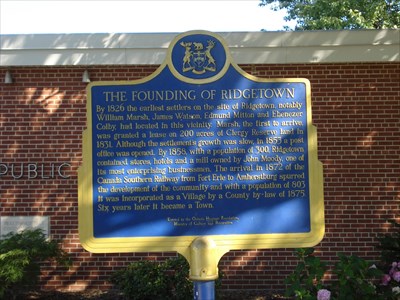
"THE FOUNDING OF RIDGETOWN"
N 42° 26.271 W 081° 53.337
17T E 426885 N 4698774
Located in front of the Public Library an Street W. in Ridgetown.
Waymark Code: WM9B9R
Location: Ontario, Canada
Date Posted: 07/26/2010
Views: 12

THE FOUNDING OF RIDGETOWN
By 1826 the earliest settlers on the site of Ridgetown, notably William Marsh, James Watson, Edmund Mitton and Ebenezer Colby, had located in this vicinity. Marsh, the first to arrive, was granted a lease on 80 ha of Clergy Reserve land in 1831. Although the settlement's growth was slow, in 1853 a post office was opened. By 1858, with a population of 300, Ridgetown contained stores, hotels and a mill owned by John Moody, one of its most enterprising businessmen. The arrival in 1872 of the Canada Southern Railway from Fort Erie to Amherstburg spurred the development of the community and with a population of 803 it was incorporated as a Village by a County by-law of 1875. Six years later it became a Town.
History:
Ridgetown, like most farming communities in Southwestern Ontario, was established late in the 19th century by English settlers that swarmed into the area after the war of 1812. Talbot Trail, also known as highway 3, still runs along Lake Erie from Windsor to Niagara Falls only minutes south of Ridgetown and was used the main passageway for travellers and settlers. Farmland was cheap and to accomodate the influx of aspiring land owners from the British Isles as well as from northern states roads were created with farm parcels staked out on each side. By 1822 each farm plot had a settler on it. The first settlers in Ridgetown were James Watson, Edmund Mitton and Thomas Scane. Other founders included Ebenezer Colby and Mr. and Mrs. Marsh. These people are still familiar not just from the street signs that bear their names, but from their descendent families that still populate the area. These settlers cleared the land, planted grain without having tools, fully developed roads, livestock or much money. They built log shelters, none of which remain today. However, the first brick home was built in 1855 and still stands today on the Main Street as Dr. Campbell’s Dentist Office. The first store was built in 1853 as a saloon and small grocery. Over the next 25 years Ridgetown grew immensely with frame houses selling at $150 a piece. Several of these original homes are still present today. A saw mill was built as well as churches, several factories and merchants expanded their wares. In 1875 the population grew to 1,027 people and Ridgetown was considered a village until it grew to become a Town with 2,197 people in 1880. This growth spurt can largely be attributed to the laying of the Canadian Southern Railroad in 1872. In the present day, these tracks, which ran in between Ridgetown and the village of Morpeth, are long gone with no traces evident. What is still evident of the once popular railroad that had two tracks running right into town is an old station, which still sits just off of Erie Street North. Another station was moved and is now a beautiful and unique home on Edward Street. Houses such as the Ridge House Museum is typical of what was built between 1872 and the 1890s. Most were middle class homes that cost around $200 to construct. Coal oil provided light, streets were just dirt pathways and animals roamed the town. However, by 1888 the Ridgetown Natural Gas Company laid pipes to provide natural gas for both heat and lighting. Some institutions such as the Howard Mutual Insurance Company (est. 1872) and the Ridgetown District Agricultural Society (est. 1854) still exist today.
Information taken from: Visit website